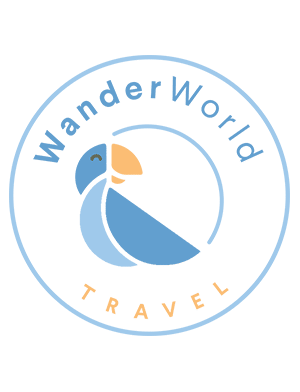Colombia
Fascinating colonial cities, exuberant atmosphere on endless Caribbean beaches, endless rainforest and endless coffee plantations – you will find all this and much more in Colombia. Visit the up-and-coming metropolis of Latin America and experience the real big city feeling. Let yourself be enchanted by the warmth and hospitality of the Colombians and swing your hips to the fiery rhythms of salsa. Colombia is still a real insider tip, so pack your bags quickly and get going. We guarantee you the time of your life.
Favorite places
Bogotá
The capital of Colombia is located in the interior of the country in the middle of the Andes. With 8 million inhabitants, it is also the country’s largest city and economic center. Bogotá is flashy, urban and multicultural. Modern skyscrapers rise into the sky and old buildings with red-tiled roofs recall the colonial past. The many parks and trees that can be found throughout the city form small oases in the big city hustle and bustle.
The old town La Candelaria is the most popular neighborhood among travelers, so you can find many cool hostels here. Here you can find the government palace and the famous Plaza Bolivar, named after the independence fighter and national hero. The buildings in this neighborhood are from colonial or republican times and are well preserved until today.
Every Sunday the “Ciclovia” takes place, a kind of small folk festival that attracts people out of their houses. The streets are closed to traffic in the morning, making way for flea markets, street performers and longboarders.
Be sure to visit the Usaquén neighborhood, which gives you the feeling of being immersed in a small village in the middle of the city. Stroll through the narrow streets, admire the handicrafts of the inhabitants and take a break in one of the countless restaurants and cafés.
In an abandoned railroad warehouse is Bogotá’s most iconic market, Plaza de Paloquemao. The many exotic fruits and vegetables for sale here attract fruit and vegetable lovers from all over the world.
Don’t miss out on taking a graffiti tour. Graffiti art has a special meaning in Colombia and especially in Bogotá and has strongly influenced the culture of the city in recent years. Numerous artists express here their ideas and feelings regarding the social, political and economic situation in Colombia.
The highlight of your visit to Bogotá is the climb to the city’s most famous viewpoint, the local mountain Montserrate. From here you have a fantastic view over the mega metropolis and the surrounding hills. If the 500 meter walk is too strenuous for you, you can simply take the cable car to the top. The view is especially beautiful at sunset, when the sea of houses begins to shimmer in the evening light.
- To and from Bogotá
Bogotá is served by many German airports. From there you can get to all parts of the country. - From Bogotá you can fly to Cartagena in only 1.5 hours.
- The city of Medellín can be reached by plane in 1 hour. Ticket prices vary between 50 – 100 Euros. Alternatively, there are night buses, the journey takes about 12 hours and costs around 30 euros.
- From the airport of the Colombian capital you can reach almost all countries in South and Central America without a stopover.
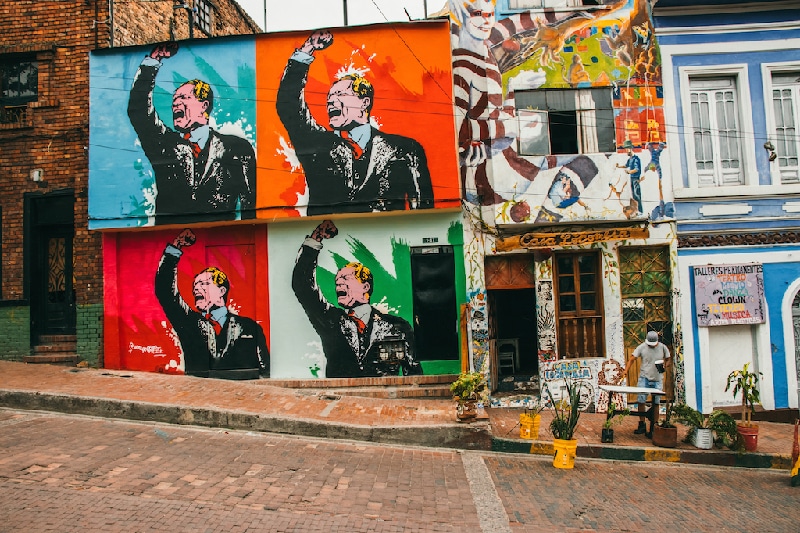
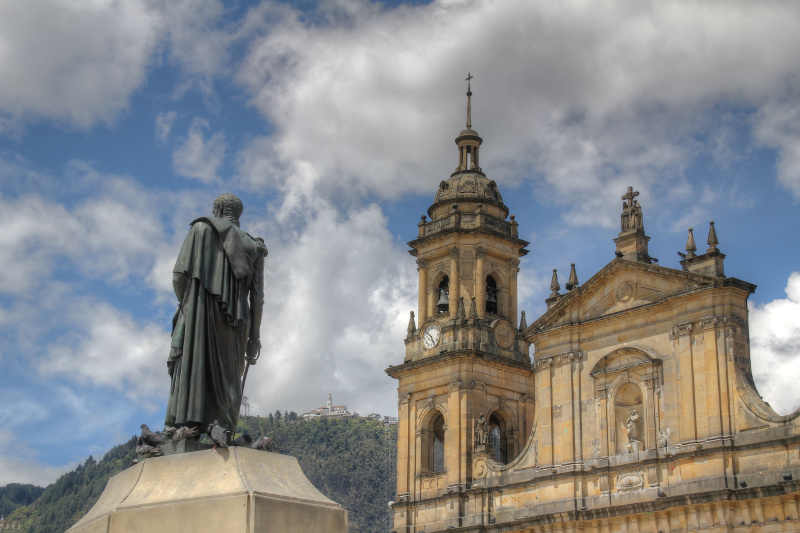
Medellín
Even the name Medellín sounds mysterious and enticing. The former stronghold of Pablo Escobar has developed into a hip metropolis whose future has just begun. The city has reinvented itself and left its bloody past behind. While it was called the most dangerous city in the world in the 1960s, Wall Street magazine recently named it the most innovative metropolis in South America. It no longer appears on the list of the world’s most dangerous cities. The traces of the devastating time can be explored in the Casa de la Memoria museum. Today, only the graffiti on the walls of Comuna 13 remind of the time and tell of the liberation action of the district. Here, in addition to the many colorful houses, there is also the longest escalator in the world, which runs through the middle of the neighborhood. The ride is free and definitely worth it. Or you can take a ride on the cable car and take a look at the metropolis from above.
The gastronomy scene also experienced a brisk upswing. The El Poblado district is known for its numerous stylish restaurants, hip bars and its turbulent nightlife. The club scene in the Parque Lleras neighborhood can easily compete with that of a major European city. On weekends, well-known DJs from all over the world play here.
In Medellín’s surroundings you will find fabulous places that are worth a visit. Guatapé, 1.5 hours away, is one of the ten most picturesque villages in the world. Curious, colorful ornaments adorn the facades of the houses here. There are cute cafes and great restaurants on every corner. The village is located on the artificial reservoir Guatapé-Peñol, where you can admire the many small islands on a boat tour. Here are the abandoned villas of Pablo Escobar and his henchmen, the ride will immerse you in a bygone era.
If you want to enjoy a fantastic panoramic view of the surroundings, you can climb a long staircase to the top of the huge granite rock Peñol. Watching the magical sunset from there is a moment you won’t soon forget.
Medellín has an international airport and can therefore be reached by plane from all over Latin America and also from some European cities. From Bogotá, the city is separated by 400 km, which can be covered either by plane or by bus. Da die Flüge innerhalb Kolumbiens sehr günstig sind, kannst du von hier aus auch einfach nach Cartagena oder Santa Marta weiterfliegen. Auch die Kaffeeregion ist nach einer etwa 8-stündigen Busfahrt erreichbar. Dies macht Medellín zu einem zentralen Punkt und lässt dir viele Möglichkeiten offen, wo dein Abenteuer im Anschluss weiter gehen soll.
To and from Medellín
- You can reach the city of Medellín from Bogotá in 1 hour by plane. Ticket prices vary between 50 and 100 euros. Alternatively, there are night buses, which take about 12 hours and cost around 30 euros.
In 3 hours you are in Cartagena by plane, the costs are between 80 and 130 euros. - To get to the city of Cali, it takes 9 hours by bus, for about 8 to 25 euros.
- By plane you need only 2.5 hours for a ticket price of 80 to 120 euros.
From Medellín to Guatapé you can get by bus in 1.5 hours for a few euros.
Salento can be reached by bus in 7 hours. The trip costs between 10 and 20 euros.
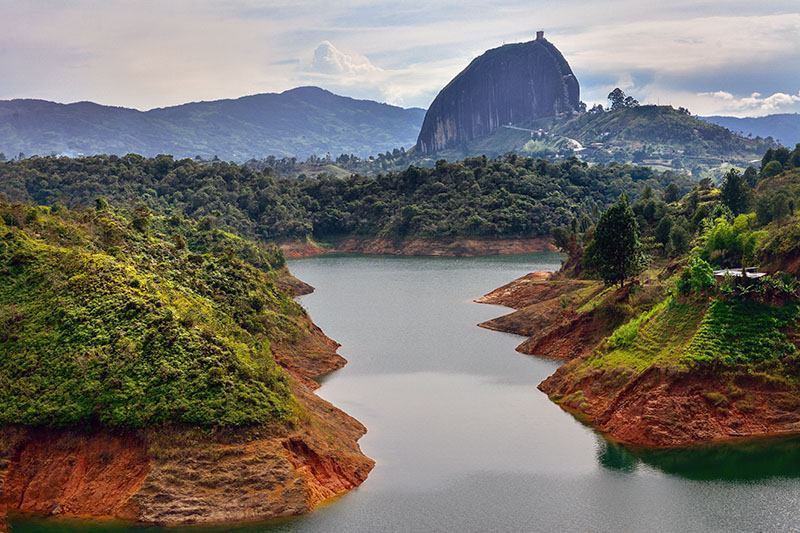
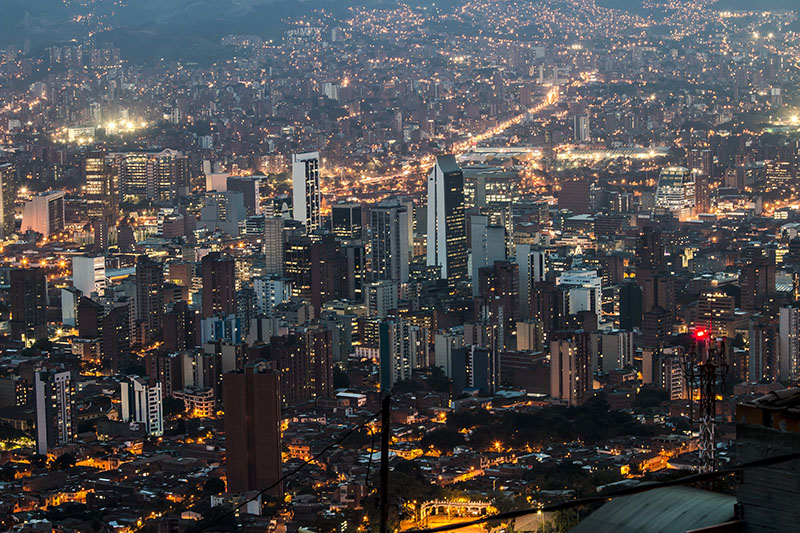
Cartagena
Welcome to the pearl of the Caribbean! Cartagena absolutely deserves this name, because the city is one of the most beautiful in all of South America and is not for nothing a UNESCO World Heritage Site. When you walk through the narrow streets, past numerous cigar bars, and watch the turbulent hustle and bustle in the streets, you could think you were in Cuba. For days you can stroll through the narrow streets, admire the colorful houses with ornate wooden balconies or watch dance groups without getting bored. The houses decorated with loving details will make you constantly discover new things. Listen to the sounds of street musicians and taste delicious street food to fully enjoy the Caribbean atmosphere. The old town is surrounded by the 13 km long Las Murallas city wall, which once protected the city from pirate attacks.
But Cartagena consists not only of the charming old town, but also of a modern center, from which skyscrapers shoot up into the sky. You can get a perfect view of both parts of the city from the Castillo San Felipe de Barajas, a fortress that is considered a prime example of 16th-18th century military architecture.
Of course, the Caribbean city also has its own city beach. However, it is much nicer to go to one of the nearby islands and enjoy the endless white beaches.
If you are looking for a Caribbean feeling in an exciting and culturally rich city, Cartagena is the place for you. You will quickly take this small town to your heart and feel at home. Whether you want to stay in a hostel or work in a volunteer project, this beautiful place has something for everyone. And after work or on weekends, Cartagena is the perfect starting point for relaxing on the endless Caribbean beach with crystal clear water or other activities. So it’s perfect for your adventure.
From and to Cartagena
- Cartagena can be reached by plane from Medellín or Bogotá in a few hours.
- You can get to the famous Tayrona National Park with a stopover in Santa Marta. The trip takes about 4 hours by bus and costs between 4 and 10 Euros.
- For a weekend trip you can go to the Baru Peninsula. With a cab you will be there in about 40 minutes and pay about 40 euros.
- You can get to the island Tierra Bomba daily by boat for about 5 euros. The ferry ride takes only 10 minutes.
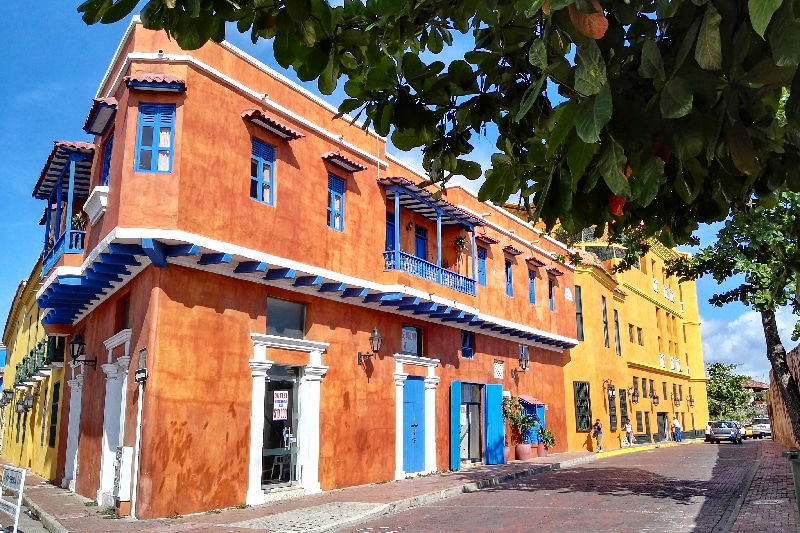
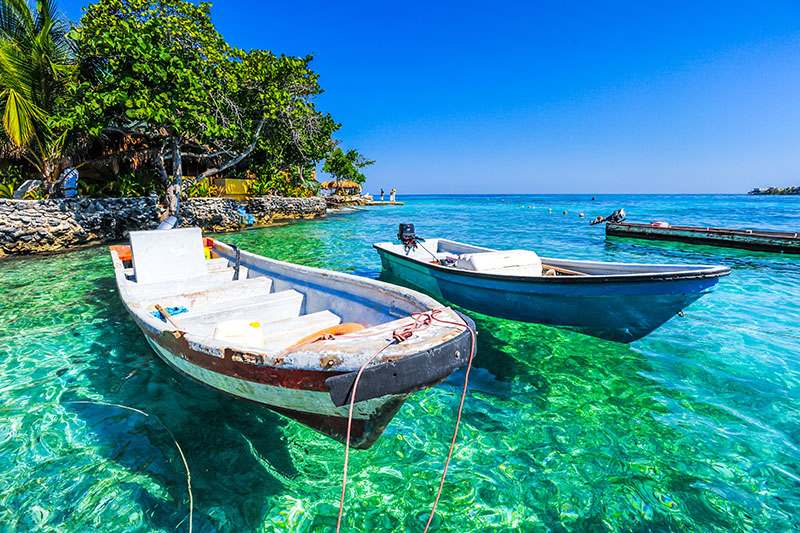
Santa Marta Area
If you drive from Cartagena further east along the coast, you will reach the small town of Santa Marta after only a few hours. In contrast to the hustle and bustle of Cartagena, Santa Marta is very quiet and enchants with its very own colonial charm. It was founded as the first Spanish city in the Americas by the colonial masters and the cathedral here is one of the oldest in Latin America. From the city, you’ll have a great view of the snow-capped peaks of the Sierra Nevada de Santa Marta, an imposing coastal mountain range that rises to 5,775 meters, just 50 kilometers away.
If you decide against the big city of Cartagena on the Caribbean coast, but are still looking for summer, sun, beach and sea, Santa Marta is the perfect place. The beauty of this place is that you are right between the Caribbean, the jungle and the mountains. A unique combination that you don’t find often in the world and which offers you numerous options for leisure activities.
One hour away from Santa Marta is one of the most beautiful places in Colombia. The Tayrona National Park is fascinating and unique. Untouched nature, turquoise water and enchanting beaches attract visitors. The dream beaches can be reached after an adventurous walk through the jungle. Here live parrots, sloths, monkeys and coatis, which you can observe with a little luck in the wild. After two hours you will reach the dream beach La Piscina and Cabo San Juan. Behind the beautiful bays you will see both the deep green rainforest and the snow covered mountains of the Sierra. A breathtaking and unique sight. In the bays you can snorkel with turtles or just relax.
If you don’t want to leave this paradise after just one day, you can set up camp in the park. If you want to enjoy the peace and solitude, you can find a secluded spot, otherwise you will find other adventurers to join you. In the relaxed atmosphere and among so many like-minded people from all over the world, you almost feel like you’re at a festival.
Another highlight of the region is a multi-day hike to Ciudad Perdida, which means lost city. This mystical place is often referred to as Colombia’s Machu Picchu, as it is just as fascinating and unique as the wonder of the world in Peru. All sorts of secrets lie dormant here, as the city was not entered by humans for 400 years. 1975 wurde sie von Grabräubern entdeckt, die begannen, sie auszuplündern, bis die Regierung wenige Zeit später eine archäologische Expedition schickte, um zu retten, was noch zu retten war. Langsam wachen die Ruinen aus dem Dornröschenschlaf auf und einige wenige Touristen bahnen sich den Weg durch den Dschungel, um diesen magischen Ort zu besuchen. Eine Tour dorthin solltet ihr unbedingt mit einem Guide unternehmen. Der Weg dauert vier bis sechs Tage, doch er ist jede Mühe wert. Du wirst dich wie Indiana Jones fühlen, wenn du die spektakuläre Landschaft durchschreitest und viele kleine Dörfer der Ureinwohner auf dem Weg passierst.
To and from Santa Marta
- You can reach Santa Marta from Medellín and Bogotá within 3 hours by plane.
- From Cartagena you can take a bus to Santa Marta and pay between 5 and 10 euros for the 4-hour trip.
- From Santa Marta to Tayrona National Park it takes only 40 minutes. The bus ride costs a few euros.
- From Santa Marta to Minca it takes only one hour by bus and costs only 2 euros.
- Palomino is only a 1 hour bus ride for about 2 Euros.
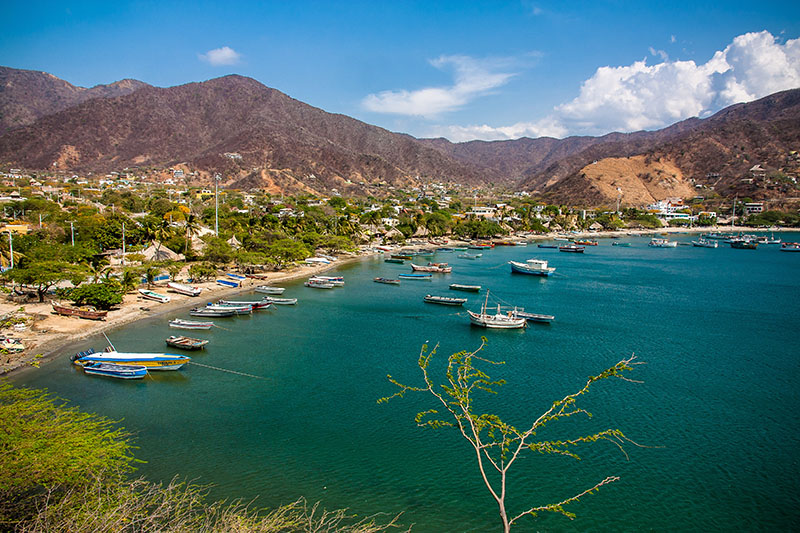
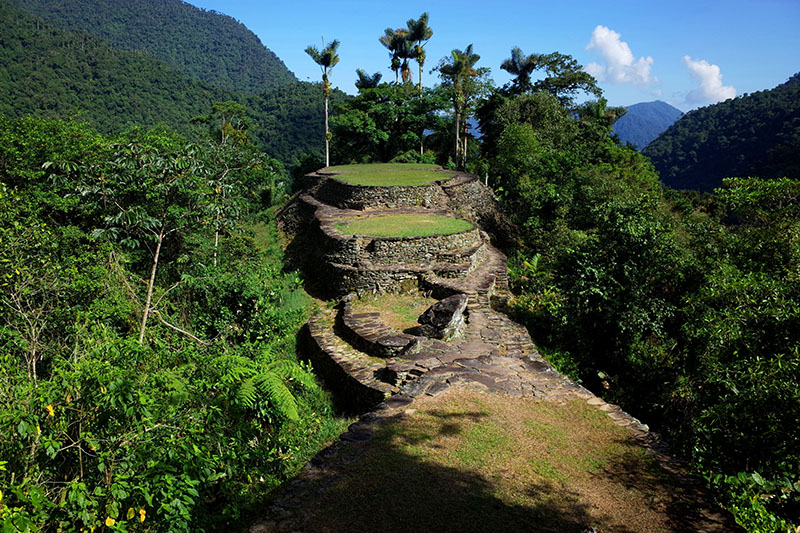
Salento and the Coffee Valley
The Colombian coffee region “Eje Cafetero” is located in the center of the country, about 200 km west of Bogota. The location offers optimal conditions for successful coffee cultivation: temperate climate with plenty of sunshine at an altitude of 1,000 to 2,000 meters, fertile volcanic soil and sufficient rainfall. Therefore, one of the best highland coffees in the world can thrive here. The perfect place for all Frahling lovers, because here everything revolves around the fine drop.
You can explore the region from different places. Usually you arrive in the capital of the Armenia region, which you reach by plane or bus. While walking through the city, it is obligatory to stop at different cafes and try a “tinto” (black coffee) or “pintadito” (coffee with a shot of milk).
In this region there is also the small mountain village of Salento, whose colorful and cheerful architecture will put you in a good mood. Salento is the starting point to the Los Nevados National Park through the Valle del Cocora – a valley where you will find impressive forests of Quindio wax palms. This type of palm is so unique because, at 60 meters, it is the tallest palm in the world and the only one of its species that grows in cold climates. It was also named the national tree of Colombia. You can ride through the valley or explore it on an extensive hike. Statte unbedingt dem Casa de Colibri einen Besuch ab. Hier kannst du den kleinsten Vogel der Welt aus nächster Nähe betrachtet.
From and to Armenia
- You can get from Armenia to Salento by bus in just one hour. The trip costs only a few euros.
- By plane from Cartagena you can reach Armenia in about 4 hours for about 100 euros.
- From Medellín to Armenia you need only one hour by plane and the ticket costs also between 60 and 100 euros.
- From Bogotá you can reach Armenia by bus in about 8 hours for about 15-20 euros.
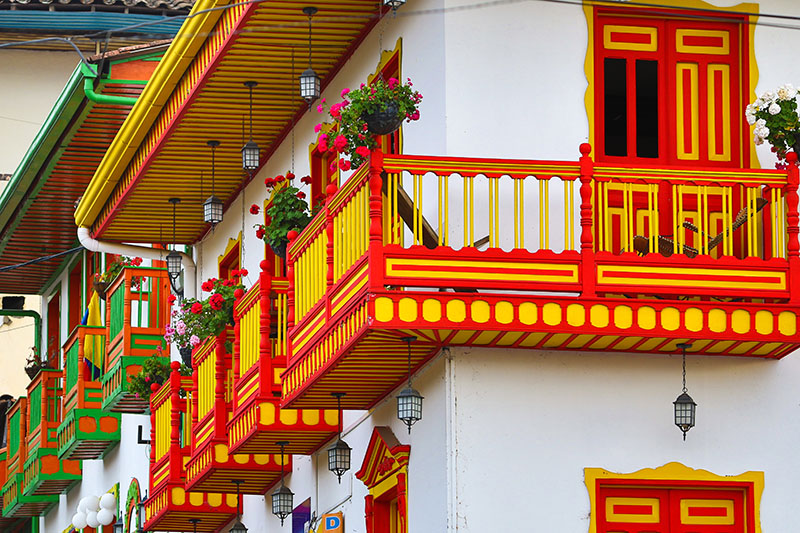
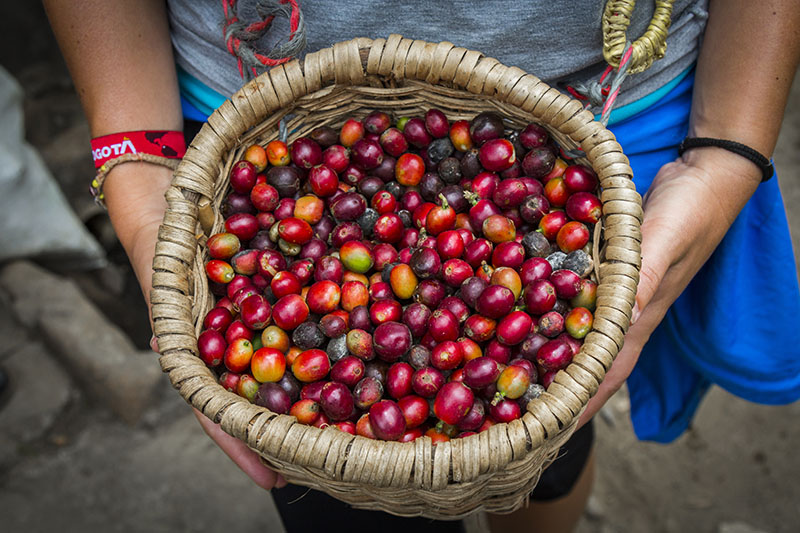
Caño Cristales – The most beautiful river in the world
Located near the municipality of La Macarena in inland Colombia is the Caño Cristales, also known as the “most beautiful river in the world” or the “river of 5 colors” (yellow, blue, green, red and black). The water is so clear and transparent that you can see various aquatic plants, sand and impressive rock formations.
The river is not very wide, at its widest point it does not reach 20 meters, and is not more than 100 kilometers long. This is the reason why it is called “Caño” (water jet).
This extraordinary natural wonder can be visited only six months a year – from the beginning of June to the end of November. In the rest of the months, access to the river is not granted. But it would not be worth it either, since the plants that cause the fascinating colors are in the process of reproducing.
Many accommodations can be found in La Macarena, which is the starting point of your Caño adventure. From here you will have to cross the Guayabero River by small boat (about 20 minutes). Afterwards, you will find suitable vehicles to drive along the dirt road. The trip takes about 25 minutes until the drivable path ends and you have to walk the rest of the way. This one-hour hike through the stunning surrounding landscapes is such a wonderful experience that the trip is worth it for that alone.
From and to La Macarena
- You can reach La Macarena from Bogotá by night bus in about 12 hours and the trip, for about 20 euros.
- From Medellín, you can get to La Macarena by bus via the town of “Neiva” in about 10 hours, for about 20 euros.
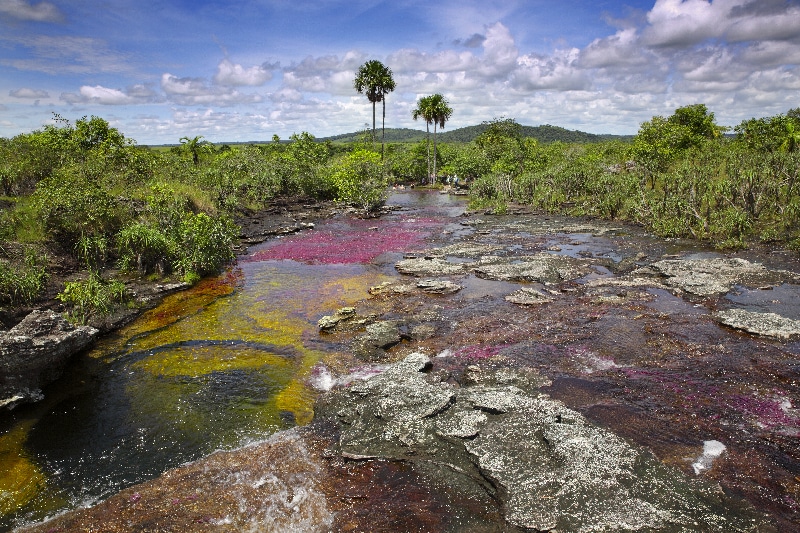
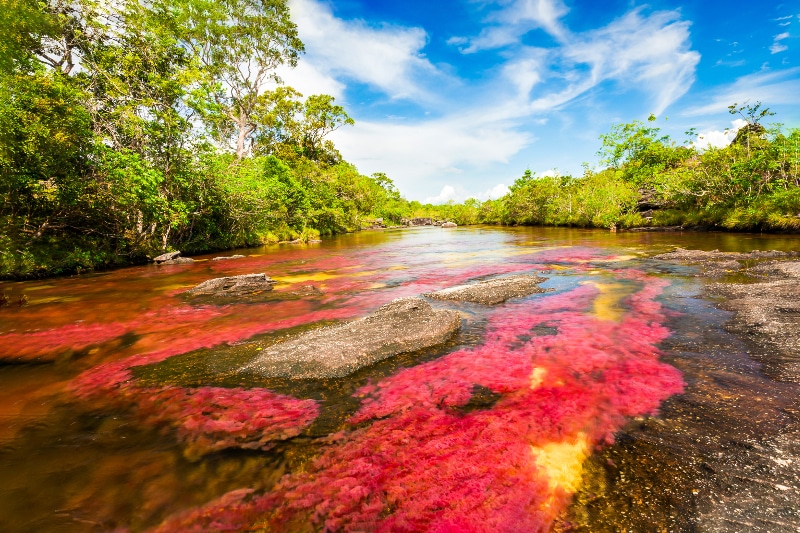
Providencia
In the middle of the Caribbean, about the same level as Nicaragua, the volcanic rock of Providencia rises from the ocean. This paradisiacal island is the second largest within the Colombian archipelago and is home to approximately 5000 inhabitants. Compared to its bigger sister island San Andrés, Providencia is still an insider tip and impresses with its original, peaceful idyll. If you are looking for absolute relaxation, lovely people and a breathtaking natural scenery, you have come to the right place.
Especially divers and snorkeling fans get their money’s worth here. In the crystal clear water, between the gentle whitecaps of the ocean, unique coral reefs, turtles, rays and iridescent fish can be admired.
To explore Providencia, you can take jungle hikes through the lush forest, circle the island on a kayak tour, or even take a horseback ride through the paradisiacal setting. Gallop across the white beach on horseback or trot through the dense rainforest. For less animal-loving travelers, there are also bikes to rent to go exploring.
From the main town of Santa Isabel, a brightly painted wooden bridge, also called the “Bridge of Lovers”, leads to Santa Catalina, a small island in the northwest of Providencia. There you will find many more dream beaches, bars and untouched nature.
An unforgettable experience is the view from the hilltop of the island. After a short climb you will reach the highest point of Providencia, where you will have an incomparable view. Behind the rolling green of the forests, the white sandy beaches stand out, and beyond them stretches the endless, crystal clear sea. A spectacular panorama that you will never forget!
From and to Providencia
- Providencia can only be reached from the Colombian mainland by plane via a stopover in San Andrés. From there, the airline Satena flies several times a day to Providencia.
- Alternatively, a catamaran travels to the dream island three times a week, at a cost of several hundred euros.
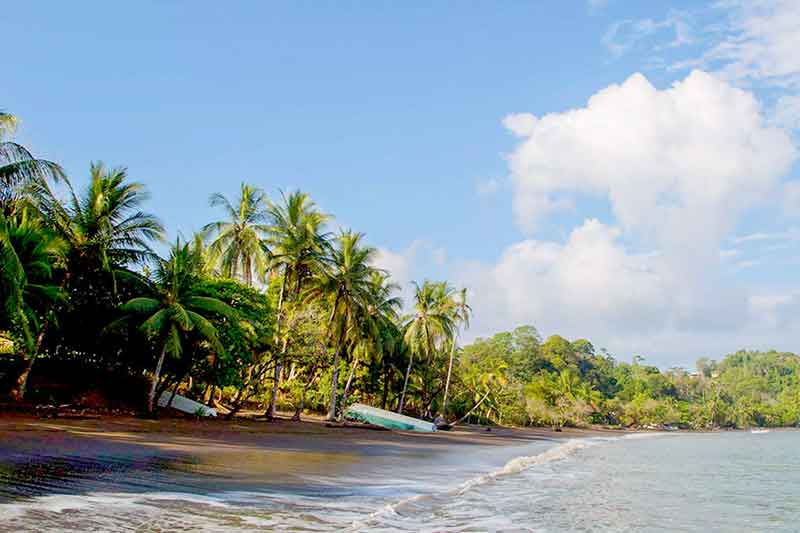
country & people
Open, cordial, courteous – Colombians immediately take you to their hearts and do the same the other way around. The people are happy about the visit of people from all over the world and also like to invite you for a coffee, true to the motto: Mi casa es tu casa (My house is your house). Colombians are very proud of their country and rightly so. Because Colombia has an incredible amount to offer and to discover.
The diverse traditions of the people are reflected in the many festivals and the carnival. There is always a reason to celebrate for the Colombians. They love to express their emotions in salsa and cumbia, and they love to do so until the wee hours of the morning – the perfect place to try out your dancing skills yourself.
The roots of Colombians can be found in handicrafts, archaeological sites, painting as well as sculptures by famous artists.
The country is on the upswing and you can feel it at every corner. Colombia has dark times behind it, the era when the narcos ruled the country was not long ago. People enjoy freedom and good vibes – a feeling that will carry you away.
The national language in Colombia is Spanish; but with a very special accent that you will quickly love. Because when Colombians talk, you hear the melodic undertones that permeate the entire culture – an absolute delight.
Food & Drink
Colombian cuisine is varied and incredibly delicious.
Just as Peruvians and Chileans fight over the origin of pisco sour, there is rivalry between Colombia and Venezuela over the tasty arepas (saltless corn pancakes eaten instead of bread). These are always an integral part of any breakfast or other meal. Depending on the region or taste, the arepas are filled with minced meat, cheese or egg.
Another typical dish for breakfast or as a snack in between meals are the so-called tamales, a banana leaf filled with rice, vegetables and pork.
At the coastal towns you can get freshly caught fish, whereas the inland towns tend to concentrate on meat dishes.
But also vegetarians will be happy in Colombia. Especially in places where there are many backpackers, there are excellent vegetarian restaurants on a high level. But also in more remote areas, the restaurants are adapting more and more to vegetarians and you can get a delicious meal everywhere.
Other local specialties include ajiaco, a creamy chicken soup with various types of potatoes and corn on the cob, usually garnished with cream and capers, and bandeja paisa, a meat dish made with cassava, pollo asado, charcoal-grilled chicken often served with chips and salad. As in most Latin American countries, grilling meat over an open fire is popular and widespread, as is sancocho, “hangover breakfast” in Colombian, a soup with chicken, plantains, cassava, cilantro, onions, potatoes and corn.
In any case, you can’t miss to taste the world famous Colombian coffee. Colombia is one of the largest coffee producers and the largest producer of Arabica coffee in the world. An absolute palate experience for all frahling lovers.
Due to the tropical location of the country, there is also no lack of delicious tropical fruits. In addition to the classics, you should also try the fruits that are usually unknown to Europeans – you will get a taste for exotic varieties such as Andean berries, tree tomatoes, guava, mamoncillo, granadilla, lulo, pitahaya or borojó.
Travel-Insider
Best time to travel
Colombia is suitable for travel all year round. Although there is a dry and rainy season here, the climate varies from region to region.
The Caribbean resorts are best visited from December to April. During the rest of the months, it is the rainy season there. The heaviest rain showers occur in October. But don’t shy away from the rainy season. Colombia has a tropical climate, which means that it can rain heavily for 1 – 2 hours a day, but the entire day does not fall in the water; because afterwards there is bright sunshine again. In the Amazon region, for example, the climate is tropical all year round and the rainforest blossoms even more during the rainy season. In the city of Medellín, people talk about the “eternal spring”, because the city has a pleasant temperature all year round.
So when planning your trip, you should pay less attention to the dry or rainy season, but rather make it dependent on what your plans are and what areas you want to travel to.
Transportation
In Colombia, you can travel comfortably by plane or by intercity buses. All tourist places are well-connected.
In addition to the major airlines, there is a local low cost airline – Viva Colombia – that also connects smaller places at acceptable rates.
For longer distances you can take a night bus. This is easily possible on the main routes. However, to see some beautiful landscapes, it is recommended to travel during the day.
In cities, you can get around by cab, Uber or collectivo.
Visa
You can participate in all our programs in Colombia with the tourist visa. The maximum duration of stay with the tourist visa is 90 days. You can extend the visa for another 90 days on the spot. The migration authorities determine the length of stay by stamping your passport at the border crossing points or at the international airports. Therefore, you should make sure at the entry control that you are given the appropriate number of days that covers your period of stay. The extension of the visa for another 90 days can be applied for in Colombia at the “Migración Colombia” (fee required). You can find a migration office in all larger cities. Usually, a one-time extension for another 90 days is granted, but there is no right to it.
Travel expenses
The national currency in Colombia is the Colombian peso. 1 Euro is equivalent to 4,000 COP.
A flight from major German cities to Bogotá or Medellín costs 600 – 900 euros. Of course, this depends on the time of travel. Domestic flights are available for as little as 20 euros. The Colombian low cost airline Viva Colombia or Avianca or LATAM can be used.
In Colombia you can eat and drink cheaply. A local lunch menu usually costs between 2 and 4 euros. If you prefer international cuisine, you should expect 4.50 to 7 euros per meal.
Taking buses and cabs is very cheap. For a cab ride within the city you will usually pay no more than 4 euros, depending of course on the distance traveled. A ride on the metro in Medellín costs about 0.50 euros. The conventional bus is even cheaper.
History and culture
The history of Colombia is probably one of the most interesting. The oldest traces of Colombia’s settlement history found so far go back as far as 20,000 years. Around the year 600 A.D. the high culture of the Chibcha, also called Muisca, developed, who had special skills as craftsmen, weavers or e.g. dyers of cotton. They built magnificent temples as well as, for example, one of the largest pre-Columbian cities in the Americas, the “Ciudad Perdida”. However, this people was wiped out with the Spanish settlement. Also contributing to the identity of the Colombians were the Africans brought to the country from the early 17th century. They were brought to South America as slaves to support, for example, coffee cultivation or gold production. However, the former slaves remained in the country, which was later reflected mainly in the culture and population structure of Colombia. When the Spanish settled the country, they founded the cities of Santa Marta, Cartagena de Indias and Santa Fe de Bogotá. The Colombians fought for a total of 9 years for their independence from Spain and finally achieved it in 1819.
In 1957, conservatives and liberals concluded an agreement with the “National Front” that stipulated a change of government by the aforementioned parties every 4 years. However, left-leaning groups in particular felt disadvantaged, and guerrilla groups formed in parallel to fight against the policy. As a result, paramilitary associations were also increasingly formed at the end of the 1970s. Thus crime and human rights violations in the country increased dramatically. In the following years, more and more guerrilla groups were founded, e.g. the FARC and the M-19. However, this was not the only enemy of the country; in addition, there was the drug trade of the Cali and Medellín cartels, which became bigger and bigger from the 1970s on. Die narco barons, as well as the heads of the guerrilla groups, tried again and again to make deals with the government. Whether some of them have worked out remains unclear to this day. Eine relief for the country was the death of Pablo Escobar in 1993 and the arrest of the drug lords of the Cali cartel. However, it was not until 2016 that peace was made with the largest guerrilla group, FARC. This asked the long-awaited chance for Colombia to develop without terrorizing forces. Colombians cherish this peace and tranquility and now want nothing more than to maintain it forever.
WanderWorld Insider Tips from our contributor Carlota
Our employee Carlota did not miss the chance to travel through a blossoming, young country. Many places and events have remained in her memory and still bring a smile to her lips today. To make sure you have an equally great time in Colombia, she has summarized her personal highlights for you.
- Cartagena is definitely my favorite place in Colombia. There is always something going on here, the colorful streets put you in a good mood and there is no lack of restaurants. In the evening, street artists and food trucks gather at a small square in the middle of the old town, so you can always discover something new.
- On the island Tierra Bomba I visited our Youth Development Project and was welcomed by the children with open arms. Their friendliness and interest in me along with the Caribbean environment touched me incredibly. I was allowed to participate in a workshop with them and it made me so happy to see how little the children here get by with and how much they enjoy little things.
- From Santa Marta I took a trip to Minca away from the beaches and into the mountains. There I was able to relax on a huge hammock, visit cocoa and coffee plantations, and hike up one of the many mountain peaks in the evening for sunset. To cool off here, you jump into one of the clear waterfalls and rivers, all hidden in the tropical jungle. There was really something magical about this place and I hope to come back here one day.
- My last highlight is the Colombians Rarely have I met such friendly people. Loud music plays at all times of the day, young and old chat and you always see someone dancing somewhere. The people are optimistic and open-minded, and above all proud of their country, which has been through a lot, but has never given up.
